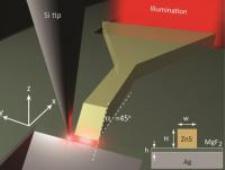Researchers at the Lawrence Berkeley National Laboratory of the U.S. Department of Energy (DOE) have developed nanoscale waveguides for advanced on-chip optical communication systems.
Xiang Zhang, a chief investigator of the Berkeley Lab's Materials Sciences Division stated that the original design of the nanoscale waveguide is suitable for several nanoscale photonic applications such as bio-medical sensing, nanoscale lasers, signal modulation and intra-chip optical communication.
 HPP waveguide
HPP waveguide
In a paper presented by Zhang and his colleagues, they have explained the use of a quasi-particle that they created and incorporated in a nanoscale waveguide system. This quasi-particle, called the hybrid plasmon polariton, was able to control light waves along a nanostructured metal-dielectric interface and over distances necessary for directing optical signals in photonic equipment.
The performance and size of photonic equipment was affected by the interference that occurs between closely packed light waves, which resulted in weak photonic-electronic interactions. These weak interactions could only be prevented with the use of devices larger than electronic circuits. It has been discovered that coupling of electrons with photons is possible by directing light between metal/dielectric nanostructure interfaces which have smaller dimensions than half the wavelength of incident photons in free space.
When light waves are directed across the metal nanostructure’s surface, it creates electronic surface waves named plasmons. The photons and plasmons interact with each other to generate a quasi-particle called a surface plasmon polariton (SPP), which functions as a data carrier. SPPs have great prospects especially because a scaling down of their wavelengths is possible below the diffraction limit but the challenge was that light signals lose strength while traveling through the metal segment of a metal-dielectric interface.
Zhang and his team developed the hybrid plasmon polariton (HPP) concept in an attempt to resolve the challenge of optical signal loss. A high-dielectric semiconductor strip was arranged on a metal interface with a low-dielectric thin oxide layer in between to enable an energy redistribution of the incoming light signal. The optical losses are low when the light wave is directed into the low dielectric gap.
The HPP waveguide system can function well with existing semiconductor/CMOS processing methods. It can also work well with the Silicon-on-Insulator (SOI) platform for the purpose of photonic integration, which proves suitable for cost-effective, large-scale manufacturing and integration.